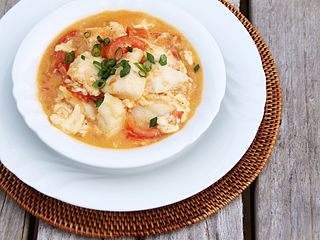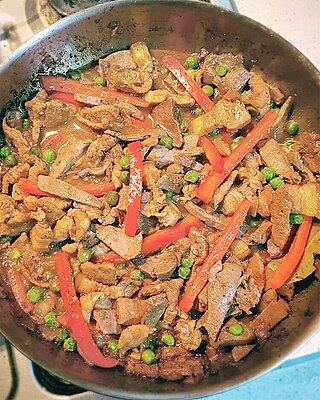
Chili con carne, often shortened to chili, is a spicy stew of Mexican origin containing chili peppers, meat, tomatoes, and often pinto beans or kidney beans. Other seasonings may include garlic, onions, and cumin.

Fried rice is a dish of cooked rice that has been stir-fried in a wok or a frying pan and is usually mixed with other ingredients such as eggs, vegetables, seafood, or meat. It is often eaten by itself or as an accompaniment to another dish. Fried rice is a popular component of East Asian, Southeast Asian and certain South Asian cuisines, as well as a staple national dish of Indonesia. As a homemade dish, fried rice is typically made with ingredients left over from other dishes, leading to countless variations. Fried rice first developed during the Sui dynasty in China.

Frito pie is a dish popular in the Midwestern, Southeastern, and Southwestern United States, whose basic ingredients are chili, cheese, and corn chips. Additions can include salsa, refried beans, sour cream, onion, rice, or jalapeños. There are many variations and alternative names used by region. Frito pie can be prepared in a casserole dish, but an alternate preparation can be in a single-serve Fritos-type corn chip bag with various ingredients as toppings.

Sofrito, sofregit, soffritto, or refogado is a basic preparation in Mediterranean, Latin American, Spanish, Italian and Portuguese cooking. It typically consists of aromatic ingredients cut into small pieces and sautéed or braised in cooking oil for a long period of time over a low heat.

Picadillo is a traditional dish in many Latin American countries including Mexico and Cuba, as well as the Philippines. It is made with ground meat, tomatoes, and also raisins, olives, and other ingredients that vary by region. The name comes from the Spanish word picar, meaning "to mince".

Honduran cuisine is a fusion of Mesoamerican, Spanish, Caribbean and African cuisines. There are also dishes from the Garifuna people. Coconut and coconut milk are featured in both sweet and savory dishes. Regional specialties include sopa de caracol, fried fish, tamales, carne asada and baleadas. Other popular dishes include meat roasted with chismol and carne asada, chicken with rice and corn, and fried fish with pickled onions and jalapeños. In the coastal areas and the Bay Islands, seafood and some meats are prepared in many ways, including with coconut milk. Among the soups the Hondurans enjoy are bean soup, mondongo soup, seafood soups and beef soups. Generally all of these soups are mixed with plantains, yuca, and cabbage, and served with corn tortillas.

Lomo saltado is a popular, traditional Peruvian dish, a stir fry that typically combines marinated strips of sirloin with onions, tomatoes, french fries, and other ingredients; and is typically served with rice. The dish originated as part of the chifa tradition, the Chinese cuisine of Peru, though its popularity has made it part of the mainstream culture.

Salpicon is a dish of one or more ingredients diced or minced and bound with a sauce or liquid. There are different versions found in Spanish and the broader Latin American cuisine and Filipino cuisine. A salpicon is sometimes used as stuffing.

Ratatouille is a French Provençal dish of stewed vegetables that originated in Nice and is sometimes referred to as ratatouille niçoise. Recipes and cooking times differ widely, but common ingredients include tomato, garlic, onion, courgette (zucchini), aubergine, capsicum, and some combination of leafy green herbs common to the region, such as chives or fennel.

Baigan bharta, also spelled bainganbharta or baigan chokha is an Indian dish prepared by mashing or mincing grilled eggplant (baigan) with tomato, onion, herbs and spices, with variations being common from chef to chef. Traditionally, cooking the eggplants over charcoals, inside of a tandoor, barbecue grill or oven, or even directly applying flame to the outside of the fruit infuses the dish with a smoky flavour; the blackened skin is then easily peeled and the eggplant may be further prepared.

Kavurma is a broad type of fried or sautéed meat dish found in Turkish cuisine. The name also refers to canned or preserved versions of a similar dish, prepared by dry frying the meat to render down the fat. Similar dishes are known in Central Asia as kuurdak. It's present in cultures and cuisines of Turkey, neighbouring countries, including the Balkans, most notably in Serbia and Bulgaria.

Sarsiado is a fish dish from the Philippines which features tomatoes and eggs. The name sarsiado in the Tagalog language means "cooked with a thick sauce". The name is derived from the Filipino word sarsa which in turn is from the Spanish word salsa, which means "sauce".

Ginisang munggo is a Filipino savory mung bean soup. It is made with mung beans, garlic, tomatoes, onions, various vegetables, and patis. It is cooked with pork, tinapa, daing, or other seafood and meat. It is also commonly garnished with chicharon. The name means "sauteed mung bean", though the dish ends up being a soup. The name is in reference to the first step of the cooking process where the spices and the secondary ingredients are sauteed before water and the mung beans are added.

Afritada is a Philippine dish consisting of chicken, beef, or pork braised in tomato sauce with carrots, potatoes, and red and green bell peppers. It is served on white rice and is a common Filipino meal. It can also be cooked with seafood.

Paklay is two different Filipino braised dishes from the Mindanao and Visayas Islands characterized by julienned ingredients. They are eaten with rice or served as pulutan with alcohol.

Poqui poqui, also spelled puke puke or puki puki, is a Filipino eggplant and scrambled eggs dish originating from the Ilocos Region of Northern Luzon in the Philippines. It is very similar to tortang talong in that the eggplant is first grilled directly on an open flame, then peeled and mashed. It is then added to ginisa and scrambled eggs. It is garnished with spring onions. It has a creamy texture and is usually eaten as a side dish to grilled fish and meat dishes, but it can also be eaten with white rice.

Igado is a Filipino pork dish originating from the Ilocos Region in the Philippines. Its name means "liver" in Spanish for which it features, although it may include other pork meats and offal also.

Carne norte guisado, also known as corned beef guisado, is a Filipino dish made from shredded canned corned beef sautéed with onion. It's a very simple dish and is popularly eaten for breakfast with white rice or pandesal. Finely diced potatoes, carrots, scallions, tomatoes, cabbage, bell pepper, and garlic may also be added. A notable variant of the dish is sinabawang corned beef, which just adds beef stock or water to the dish after sautéing, making it soupier.



















